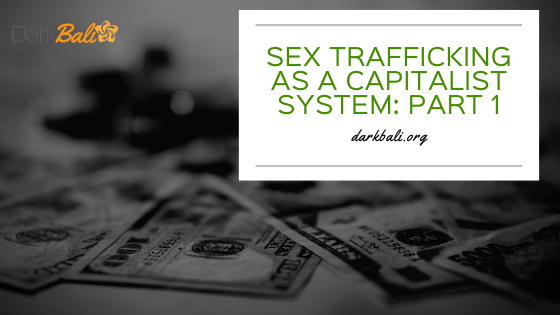(All references in text are from Kara unless otherwise noted.)
The topic of human slavery and sexual exploitation is deeply emotional for many people. There is a thread of morality that is nearly impossible to ignore when approaching the issue. The injustice of sexual slavery drives lawmakers, private citizens, and development workers to act, and this is a good thing. However, much understanding of the topic can be gained by divorcing it from emotion and a sense of morality because traffickers and buyers do not look at their activities in the sex trade through the lens of morality. For them, it is simply business, and with a net profit margin of 70%, it is one of the most lucrative businesses in the world (19).
Put in economic terms, sex trafficking is a supply chain with a supply side and a demand side. The two parts of the supply side are the product (sexual services) and wholesalers (traffickers involved in recruitment and transfer). Retailers (traffickers involved in sales such as brothel employees, pimps etc.) and customers (those that pay for sex) make up the demand side (202). The availability of “product” is driven by such forces as migration and is assisted by factors such as gender discrimination, poverty, war, and the breakdown of the state (23). Yet there could be no industry without a demand for the product. Demand, according to Kara, comes from three market forces: the demand for commercial sexual opportunities by male customers, the opportunity for profit by retailers, and elasticity of demand (explained below) (33).
At first glance, it is horrifying that the global population of men can sustain a sex industry of 4 million victims. However, Kara’s research breaks down the data to reveal that only a minuscule portion of the world’s adult men need to access the services of sexual slaves to maximize the profit potential of the industry[1] (33). This demand, though small in terms of the population, is capitalized on by retailers, though it is the elasticity of demand that regulates both.
The elasticity of demand is an important force to understand if one is to make a connection between capitalism and sex trafficking. The term describes what buyers are willing to pay for a product. This is the question of all capitalistic enterprises: “what is the best price to maximize profits in a given industry?” When sex retailers (pimps and brothel owners) market to customers in a higher income bracket, they are able to demand higher prices. However, as the supply of victims has increased, traffickers have realized that there is an untapped market in the bottom economic brackets. As with any market, “the drop in the retail price of a sex act functions exactly the same as an increase in a customer’s disposable income, and as Keynes argues, ‘the fundamental psychological law… is that men are disposed, as a rule and on average, to increase their consumption as their income increases'” (34).
CK Prahalad realized the potential in the untapped market of the world’s poorest four billion people (Prahalad and Hammond 2014). His research has driven some multi-national companies to invest in low-cost goods marketed to the world’s vast poor, because selling low cost goods in large quantities can bring enormous profits. The same is true of sex trafficking. With a seemingly unlimited supply of “product,” traffickers can sell sexual services for very small amounts of cash to meet the demand of poor male buyers. This increases the demand for more product, and the cycle continues to feed itself as long as the product remains in abundant supply. Kara’s statistical analysis of his research shows that there is a price point at which poorer customers are no longer willing to buy sex acts (driven by elasticity of demand), instead putting their money into other pursuits such as alcohol and pornography (37).
The concept of the elasticity of demand for sexual services matters greatly to those who want to see sex trafficking reduced. In fact, it is the key. As Kara writes, “If real-world prices could be doubled and achieve a decrease in demand by even one-half the amount predicted by the data I gathered, the profitability of the sex trafficking industry would be severely compromised” (37). To put it more concretely, if there was a way to drive up prices, the demand for sexual services of slaves would be reduced and it would no longer be profitable to traffic so many into sexual servitude.
[1] Working with a much smaller number of 1.2 million sex slaves (an older figure assuming the most conservative possibilities), Kara estimates that that only 0.5% of adult men are needed to purchase sex on a given day.
References Cited
Kara, Siddharth. Sex trafficking: inside the business of modern slavery. New York: Columbia University Press, 2010.
Prahalad, C.K., and Allen Hammond. “Serving the World’s Poor, Profitably.” Harvard Business Review. July 31, 2014. Accessed August 14, 2017. https://hbr.org/2002/09/serving-the-worlds-poor-profitably.






